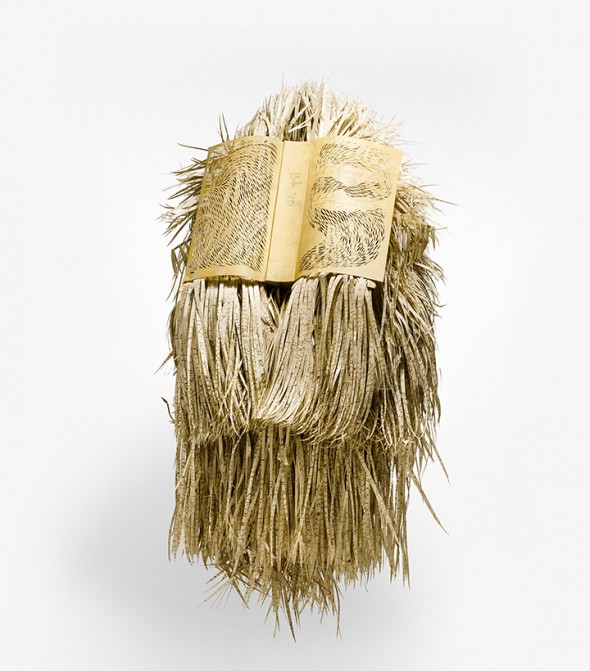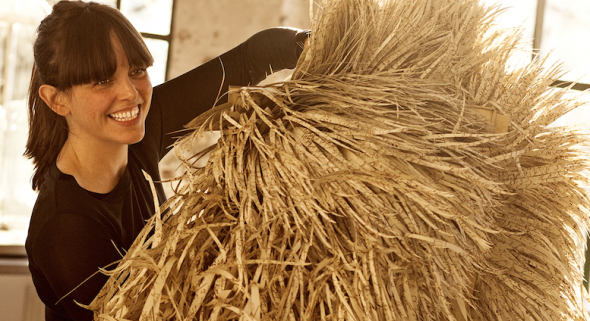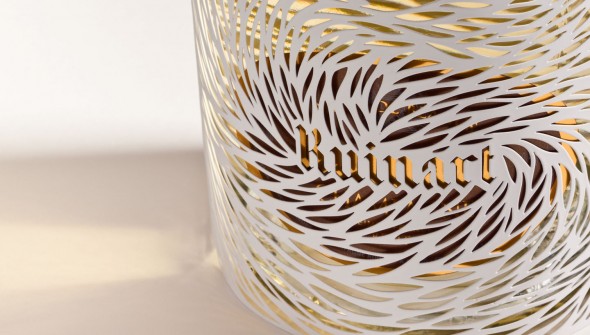 Georgia Russell – “Grand Livre” (2014), order book of the House of Ruinart; courtesy of Ruinart
Georgia Russell – “Grand Livre” (2014), order book of the House of Ruinart; courtesy of Ruinart
Artist Georgia Russell has made her name in the niche of book art. Her meticulous handiwork with a scalpel and old tomes is awe-inspiring both in its effort and aesthetic. Through the process of, in some sense, destroying a book, she creates, reconstructs, and enlivens pages into creature-like objects. The Scottish artist uses her skill to make stories and histories relevant again.
This notion of memory and the importance of recollection has brought her together with champagne brand Ruinart. The brand has long been a patron of contemporary artists and has engaged artists in the past for projects, including Dutch designer Maarten Baas. Russell has created a bottle ornament, inspired by the company’s chalk cellars used for storing and aging wine. The end result is a beautiful inclusion of her signature style, using negative space and light to activate the bottle and its Blanc de Blancs contents.
She has also created a large sculpture out of a replica of the original order book of the Ruinart company. The book is a volume of ledger notes called the Grand Livre, and records the realization of the House of Ruinart. The artwork will be on tour throughout the world in the next couple of months.
Russell took the time to talk to us a bit more about her inspirations for the project as well as her overall artistic practice, from the time-marking function of champagne, to whether she’s read the books that she chooses to “dissect.”
 Artist Georgia Russell; courtesy of Ruinart
Artist Georgia Russell; courtesy of Ruinart
Berlin Art Link: Clearly history is important to you. Ruinart has a long history, and you use a lot of old books in your work. Where does this interest come from?
Georgia Russell: I think it comes from the fact that in my generation people move around a lot more and live in loads of different places. Families are a lot more disparate. People have kids later, so you rarely have your grandparents around or share the same relationships. I remember these relationships from when I was young, but I can see now with my kid that she’s not going to have the same relationship [with her grandparents] because we live far away [from each other].
I think it’s a sense of trying to meet history and have it around you all the time. It makes you feel secure. These books are vessels of knowledge that can help you, carry you, or advise you. Even though I’ve dissected them or transformed them, they are there for us to look at and remember that these stories are important. We should know and learn from history so that it helps us in our lives.
BAL: How do you choose the books or music scores?
GR: It used to be title-based, it still is now but very rarely. I don’t actually read very much, which surprises everyone. I suppose it’s more just the actual weight of the book or sculptural qualities of the book, its color or form or weight or size. The gesture that I use on it, this repetitive action that marks time, is becoming more interesting to me now. Sometimes, it’s not the story that’s important, it’s what the actual form of the book can mean in the wide sense of the term.
 Georgia Russell – ornament for Ruinart Blanc de Blancs (2014); courtesy of Ruinart
Georgia Russell – ornament for Ruinart Blanc de Blancs (2014); courtesy of Ruinart
BAL: Can you describe exactly what this inspiration of the chalk cellars was like?
Gr: What struck me was that people had carved out this huge architectural space mark by mark. They hadn’t just done cave-like shapes, but stairs and tunnels. It’s more amazing than a great sculpture. Also the fact that people were protected there in wartime, and now of course that this champagne is housed there.
BAL: Can you explain more of this relationship between destruction and creation in your work?
GR: I think we all battle with questions like why we’re here or why we are going to die, but try not to think about it too often. When I’m working, I do things quite intuitively and then find out what it means afterwards. So when I see my work, it’s kind of caught between living and dying and going towards something that’s new or unknown.
For example, in times of change or in revolution, things have to be destroyed to find the new. Although I’m not saying that we should destroy old things at all, I think that some part of these sculptures is about my problem with things having to change to move on.
___________________________________________________________________________________
Interview by AJ Kiyoizumi in Berlin; Wednesday, May 07, 2014.
























